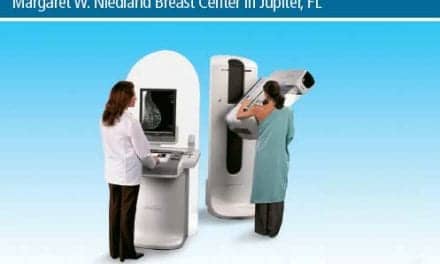Ann Verbeeck, PhD, MBA, global upstream marketing director, heads the business team responsible for the products and services that form the most comprehensive of Agfa’s solutions, Women’s Care. Along with responsibility for strategic direction, the portfolio, and the business plan, she guides the positioning for the Embrace™ for Women’s Care Solutions. Verbeeck received her PhD at the Catholic University at Leuven (Belgium), and an Executive MBA at the Catholic University at Antwerp (Belgium). Prior to this assignment, she was with Agfa HealthCare R&D, conventional imaging.
Q How important is women’s imaging to Agfa’s imaging business, and how does its profile differ from that of other sectors?
VERBEECK: Globally, over the next 2 years, Women’s Care will focus primarily on breast imaging. This is considered a key growth business within Agfa and receives broad R&D support. Women’s Care has one of the most comprehensive portfolios within Agfa HealthCare-providing choices to our customers that range from analog to digital technologies. In 2002 we introduced the Embrace™ CR and Embrace™ DR
Mammography Systems in Europe, surprising the industry with our first modality product. Mammography parameters-for example, facility sizes, integration of screening and diagnostic procedures, and adoption of digital modalities-differ around the world. This means that globally, our customers need choices in order to effectively manage their workloads.
Q Is breast imaging suffering, elsewhere in the world, from any of the same problems that it faces in the United States, such as inadequate reimbursement, breast-center closures, malpractice suits for missed cancers, and rising malpractice insurance rates?
VERBEECK: Worldwide, reimbursement is low for mammography examinations. Malpractice suits are definitely encountered less frequently in Europe than in the United States, but this is changing, with the number of medical liability suits apparently increasing in Europe.
Q Image quality is of the utmost importance in mammography, with the gold standard being film. Is digital mammography meeting the quality requirements of European mammographers?
VERBEECK: This topic is now under discussion in Europe. An advisory committee, the European Reference Organisation for Quality Assured Breast Screening and Diagnostic Services (EUREF) is working on the establishment of norms and standards for digital mammography performance.
Q How does women’s imaging figure in Agfa’s long-term plans in the medical imaging market?
VERBEECK: Women’s imaging is, for Agfa, a strategic niche market. In the coming years, the product portfolio of Agfa in women’s imaging will reach beyond mammography to include bone densitometry, and will include add-ons to regular mammographic studies, including stereotaxy, needled localization, and surgery.
Q Are there any plans for the introduction of new technology in the United States?
VERBEECK: The concept of Agfa leading the customer into the digital era is a worldwide concept. For 2004, clinical trials in United States are planned: beta-testing sites will have digital radiography (DR) mammography systems installed in the first quarter. The target of this project is to obtain the approval of the US Food and Drug Administration (FDA) for the dedicated soft-copy viewing component of Embrace DR. Pending that clearance, we will commercially release Embrace DR mammography system, including the soft-copy workstation. Several clinical trials for computed radiography (CR) mammography, based on Agfa’s needle imaging plate technology, will also begin in 2004. The goal of these installations is to obtain FDA approval for the systems as a whole. We would like to launch the Embrace CR for the United States at RSNA 2005.
Q What is driving the adoption of digital breast-imaging modalities in Europe?
VERBEECK: The advantages of operating filmless hospitals and/or filmless radiology departments are one of the primary drivers for the adoption of digital mammography. Work-flow improvements seen in filmless facilities, such as decreased staff-time needs and the increased availability of patient-care time, are also important factors. Enhanced quality and consistency of imaging motivate many institutions, and access to diagnostic tools that are not available in film-screen mammography, such as three-dimensional images, integrated reports, and computeraided detection, are additional attractions of digital breast imaging.
Q Are the dominant models for the delivery of breast imaging services different in Europe and the United States? Are any such differences expected to influence the adoption rate for digital breast imaging?
VERBEECK: The average European mammography service is smaller than its counterpart in the United States, and it is more likely to be integrated into a radiology department.
Outside the Nordic countries (where they have been established for some time), mammographic screening programs have been initiated rather recently in most European countries.
High levels of financial investment, such as those required for the implementation of digital mammography systems, can be difficult for some smaller mammography centers with low patient volumes to consider.
Kris Kyes is technical editor of Decisions in Axis Imaging News.



